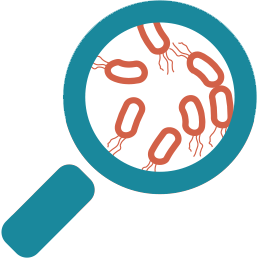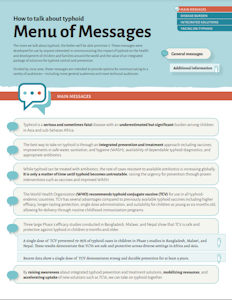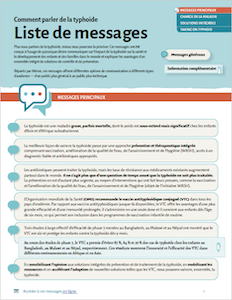The more we talk about typhoid, the better we will be able to prioritize it. The messages below were developed for use by anyone interested in communicating the impact of typhoid on the health and development of children and families around the world and the value of an integrated package of solutions for typhoid control and prevention. Divided by issue area, these messages are intended to provide options for communicating to a variety of audiences—including more general audiences and more technical audiences—and about a variety of typhoid-related topics.
 Technical Audience
Technical Audience General Audience
General Audience Main Messages
Main Messages





A single dose of TCV prevented 79-85% of typhoid cases in children in Phase 3 studies in Bangladesh, Malawi, and Nepal. These results demonstrate that TCVs are safe and protective across diverse settings in Africa and Asia.

Recent data show a single dose of TCV demonstrates strong and durable protection for at least 4 years.


 Disease Burden
Disease Burden
Typhoid is a serious and sometimes fatal disease that causes fever, fatigue, headache, abdominal pain, and diarrhea or constipation. In severe cases, typhoid can cause intestinal perforation. It places a significant and underestimated burden on children in Asia and sub-Saharan Africa, with poor communities often being most susceptible.

An estimated 75 percent of typhoid deaths occur in Asia, though recent data from Africa suggests the typhoid burden may be greater than previously thought.

Typhoid can be transmitted in either epidemic or endemic fashion.


Typhoid symptoms, such as fever and fatigue, are common to many illnesses and are often mistaken for other diseases such as malaria, pneumonia, dengue, or influenza.

Blood cultures are the current gold standard tests for typhoid diagnosis. These tests are expensive and require equipment that is not routinely available in many low- and middle-income settings with a high burden of typhoid.

The above estimates come from the 2019 Global Burden of Disease study, which uses models to estimate global disease burden numbers. Varying burden estimates from different sources, using different modeling methods, range from 9 to 21 million cases and 110,000 to 223,000 deaths per year.


Typhoid is an enteric fever and cannot be clinically distinguished from other enteric fevers caused by Salmonella enterica serovar Paratyphi. Together, the S. Typhi and S. Paratyphi are the “typhoidal Salmonella.”

Non-typhoidal Salmonella serovars can cause a serious bloodborne disease (known as invasive nontyphoidal Salmonella [iNTS]) and diarrheal disease. It may be difficult to clinically distinguish iNTS from the enteric fevers.


Current trends of drug resistance, climate change, and urbanization heighten the risk for typhoid outbreaks worldwide. Because of increased travel and transient populations, even countries that currently have little or no typhoid burden may become susceptible.

Typhoid is spread by the fecal-oral route through contaminated food and water, usually due to unsafe water, inadequate sanitation, and poor hygiene habits. This puts low-resource communities in low-income countries at the highest risk for typhoid.

If left untreated, typhoid can cause a variety of severe short- and long-term complications.

Drug Resistance

Since first appearing in the 1970s, multidrug-resistant typhoid—specifically defined as resistance to chloramphenicol, ampicillin, and co-trimoxazole—has since spread globally.

During the past 30 years, a multidrug-resistant typhoid strain called H58 has emerged and spread in many parts of Asia and sub-Saharan Africa, displacing other typhoid strains and significantly changing typhoid epidemiology. In addition to multidrug resistance, this strain has also shown reduced fluoroquinolone susceptibility.

Resistance to fluoroquinolones, the drug of choice to treat multidrug-resistant typhoid since the 1990s, and to some thirdgeneration cephalosporins is increasingly frequent, making them less suitable for use in low- and middle-income countries.

Extensively drug-resistant (XDR) typhoid emerged in Pakistan in 2016. These strains are resistant to five classes of antibiotics, leaving only one effective oral antibiotic for treatment. Most typhoid cases in Sindh Province are now XDR.



A recent modeling study predicts that TCV introduction could drastically reduce the number of drug-resistant typhoid cases and deaths over the next 10 years in Gavi-eligible countries.

Climate Change, Disasters, & Refugees



Urbanization

More than half of the world’s population now lives in urban areas, which is projected to increase to nearly 70 percent by 2050. Almost half of urban residents in sub-Saharan Africa and Asia suffer from at least one disease caused by a lack of clean water and sanitation.


Hidden Burdens Of Typhoid

Typhoid complications include a life-threatening tear or perforation of the small intestines, hepatitis, neuropsychiatric dysfunction, and secondary infections of the lungs and heart.




In Bangladesh, the cost of a single case of typhoid is typically double what the average family spends on health in a year.

A recent analysis from Malawi found that typhoid can be economically catastrophic for families, sometimes costing more than a family’s total monthly income.

Drug-resistant typhoid, which is spreading globally, forces the use of more expensive treatment options, further burdening families.

Recovery from typhoid can take weeks to months, many times requiring caregivers to miss work to take care of an ill child.

 Integrated Solutions
Integrated Solutions
The best way to take on typhoid is through an integrated prevention and treatment approach including vaccines, improvements in safe WASH, availability of dependable typhoid diagnostics, and appropriate antibiotics.


Water, Sanitation, and Hygiene

Because typhoid is spread via the fecal-oral route, the bacteria can pass to humans through food and water that have been contaminated with fecal matter.



Contaminated water and passion fruit juice sold in public markets in Uganda caused a large typhoid outbreak in 2015. Water treatment products and education about avoiding untreated beverages were an important part of outbreak control.



Typhoid Conjugate Vaccines


Compared to the previous vaccines, TCVs provide longer-lasting protection, only require one dose, and are suitable for children younger than two years of age, allowing delivery through routine childhood immunization programs.

Data from Malawi show that TCVs remain highly effective and protective after a single dose in children for more than 4 years.

Pre- and post-licensure clinical trials, post-marketing surveillance, and more than 56 million children vaccinated in introduction campaigns have reported no significant safety signals or serious adverse events related to the vaccine.


Immunogenicity studies in 9 month and 15 month old children in Burkina Faso found that TCV generated a strong immune response in vaccinated children and did not interfere with the immune response generated by other routine childhood vaccines.

Co-administration with measles-rubella and yellow fever vaccines at 9 months of age and co-administration of measles-rubella and meningococcal A vaccines at 15 months of age was found to be safe. TCV has been safely co-administered with polio vaccines (Malawi, Pakistan, Zimbabwe) and HPV vaccines (Zimbabwe).


Pakistan began introduction of TCV in Sindh Province in November 2019. In 2021, Punjab Province and Islamabad introduced TCV, followed by the remaining provinces in 2022. More than 35 million children were vaccinated throughout the campaigns in Pakistan. TCV is available nationally for all children at nine months of age through the routine immunization system.

Liberia and Zimbabwe introduced TCV into their routine childhood immunization programs in 2021. Liberia vaccinated more than 1.5 million children and Zimbabwe vaccinated more than 4 million children during the introduction campaigns. Nepal introduced TCV into its routine childhood immunization program in 2022, vaccinating 7.5 million children during its introduction campaign. Malawi introduced TCV in 2023 and vaccinated more than 7 million children.

In 2021 Samoa became the first country not supported by Gavi, the Vaccine Alliance to introduce TCV into their routine immunization schedule. In 2023, Fiji, also non-Gavi eligible, conducted an outbreak response campaign in response to increased typhoid cases in the country.



Results from a Phase 2/3 study conducted in India demonstrated that the immune response profile of TYPHIBEV is comparable to Typbar TCV.


In Hyderabad, Pakistan, TCV was found to be 95% effective against blood-culture confirmed typhoid and 97% effective against XDR typhoid.


The older WHO-recommended typhoid vaccines are an oral live attenuated vaccine, Ty21a, and an injectable Vi polysaccharide (ViPS) vaccine. Ty21a is approved for use in children six years of age and older and requires three to four doses. The ViPS vaccine is licensed for children two years of age and older with a booster dose required every two to three years. Studies show these two vaccines to be safe and to protect 50 to 80 percent of recipients.

Neither of these vaccines are routinely used in endemic areas, and uptake is low. The Ty21a vaccine requires numerous doses, and the ViPS vaccine has short-lived protection. Additionally, neither vaccine is approved for use in children younger than two years of age, which limits potential health benefits and prevents inclusion in routine childhood vaccination programs.





A recent modeling analysis projects that TCV introduction can drastically reduce the number of drug-resistant typhoid cases, deaths, and DALYs.

TCV introduction with catch up campaigns is projected to decrease the proportion of typhoid cases that are drug resistant by 16.1% in Gavi-eligible countries over 10 years.

On average, two-thirds of cases, deaths, and DALYs due to fluroquinolone resistant- and multidrug-resistant typhoid could be averted through TCV introduction.

Improving Diagnostics

Blood culture is the laboratory test used to diagnose typhoid, but it has limitations.

Blood cultures correctly identify people with typhoid in only 40 to 60 percent of cases and is greatly influenced by the volume of blood collected, prior administration of antibiotics, and the timing of collection.


Difficulties with accurate typhoid diagnostics and appropriate treatment can lead to more serious complications and contribute to drug resistance.



Results


 Taking on Typhoid
Taking on Typhoid
By raising awareness about integrated typhoid prevention and treatment solutions, mobilizing resources, and accelerating uptake of new solutions such as TCVs, we can take on typhoid together.


Raising Awareness

Current trends of drug resistance, climate change, and urbanization increase the risk of typhoid transmission, raising the urgency for prevention through proven interventions such as vaccines and WASH.


Mobilizing Resources


Accelerating Access to TCVs

In 2008, WHO recommended the use of the Ty21a and ViCPS vaccines for controlling endemic disease but highlighted the need for improved vaccines, including TCVs.

In 2017, TCVs were evaluated and recommended by WHO’s Strategic Advisory Group of Experts on Immunization, approved for funding support by Gavi, and prequalified by WHO.

In 2018, WHO formally recommended the use of TCVs in the national immunization programs of typhoid-endemic countries and countries with high rates of drug-resistant typhoid.

In 2019, Pakistan began introduction of TCV into its routine childhood immunization program. Liberia and Zimbabwe introduced TCV in 2021, followed by Nepal in 2022 and Malawi in 2023. More than 56 million children have been vaccinated so far. Several additional countries are considering TCV introduction given the prevalence and increasing risk of typhoid in their countries.

In 2020, WHO prequalified a second TCV, TYPHIBEV.



TyVAC Support to Take on Typhoid


At the global level, TyVAC generates, assembles, and disseminates data with researchers and partners across the typhoid field to help guide vaccine policy and sustainable programs.

Locally, TyVAC works closely with policymakers so that they can make evidence-based decisions about TCV introduction in their country. TyVAC ensures countries have the latest information about typhoid and TCV, and provides technical support to submit strong Gavi applications and conduct quality TCV introductions.

TyVAC works to maintain the momentum and attention on typhoid by raising awareness about the disease to motivate the global community and endemic countries to invest in typhoid prevention and control measures.





